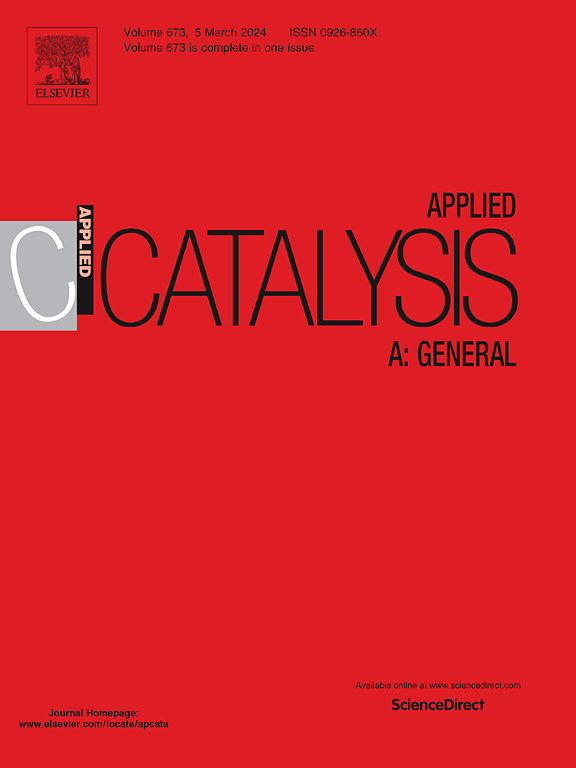Hydrogenation of 4-(2-furyl)-3-buten-2-one using Cu-double layered hydroxides modified with Zr and Ce
IF 4.8
2区 化学
Q2 CHEMISTRY, PHYSICAL
引用次数: 0
Abstract
The hydrogenation of 4-(2-furyl)-3-buten-2-one (FAc), derived from biomass through the aldol condensation of furfural and acetone, to obtain jet-fuel precursors and high-value products has been primarily performed using noble metals. In this study, the hydrogenation of FAc was studied using modified catalysts in which aluminum in CuMgAl double-layered hydroxides was partially or fully substituted with cerium (Ce) and zirconium (Zr) to induce oxygen vacancies. These vacancies were introduced to enhance catalytic performance by modifying the hydroxide structure. Characterization techniques, including N₂ adsorption–desorption, H₂-temperature-programmed reduction (TPR-H₂), N₂O-chemisorption, O₂-temperature-programmed desorption (TPD-O₂), X-ray diffraction (XRD), and X-ray photoelectron spectroscopy (XPS), were employed to characterize catalysts. The complete substitution of the Al layer with Ce or Zr significantly enhanced activity due to increased oxygen vacancy formation and improved electronic density at copper sites, resulting from variations in electronegativity. A similar product distribution at iso-conversions suggests consistent active sites across catalysts. Additionally, the Ce- and Zr-modified catalysts (CuMgCe and CuMgZr) increased selectivity toward 4-(2-furyl)-butan-2-ol, which subsequently led to the formation of 2-methyl-1,6-dioxaspiro[4,4]nonane through an intermolecular addition reaction was observed at 6 h reaction time.
Zr和Ce修饰cu -双层氢氧化物对4-(2-呋喃基)-3-丁烯-2-酮的加氢反应
4-(2-呋喃基)-3-丁烯-2-酮(FAc)是通过糠醛和丙酮的醛醇缩合从生物质中获得的,其氢化反应主要是利用贵金属来获得喷气燃料前体和高价值产品。本研究采用改性催化剂,将CuMgAl双层氢氧化物中的铝部分或全部替换为铈(Ce)和锆(Zr),以诱导氧空位,研究了FAc的加氢反应。引入这些空位是为了通过改变氢氧化物的结构来提高催化性能。采用N₂吸附-解吸、H₂程序升温还原(TPR-H₂)、N₂化学吸附、O₂程序升温解吸(TPD-O₂)、x射线衍射(XRD)、x射线光电子能谱(XPS)等表征技术对催化剂进行表征。Ce或Zr完全取代Al层显著增强了活性,这是由于电负性变化导致的氧空位形成增加和铜位电子密度的提高。类似的产物分布在等转化表明一致的活性位点在催化剂。此外,Ce和zr修饰的催化剂(CuMgCe和CuMgZr)提高了对4-(2-呋喃基)-丁醇的选择性,随后在6 h的反应时间下通过分子间加成反应生成2-甲基-1,6-二氧嘧啶[4,4]壬烷。
本文章由计算机程序翻译,如有差异,请以英文原文为准。
求助全文
约1分钟内获得全文
求助全文
来源期刊

Applied Catalysis A: General
化学-环境科学
CiteScore
9.00
自引率
5.50%
发文量
415
审稿时长
24 days
期刊介绍:
Applied Catalysis A: General publishes original papers on all aspects of catalysis of basic and practical interest to chemical scientists in both industrial and academic fields, with an emphasis onnew understanding of catalysts and catalytic reactions, new catalytic materials, new techniques, and new processes, especially those that have potential practical implications.
Papers that report results of a thorough study or optimization of systems or processes that are well understood, widely studied, or minor variations of known ones are discouraged. Authors should include statements in a separate section "Justification for Publication" of how the manuscript fits the scope of the journal in the cover letter to the editors. Submissions without such justification will be rejected without review.
 求助内容:
求助内容: 应助结果提醒方式:
应助结果提醒方式:


